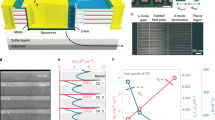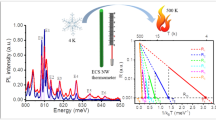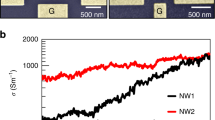Abstract
Efficient light-emitting diodes and photovoltaic energy-harvesting devices are expected to play an important role in the continued efforts towards sustainable global power consumption. Semiconductor nanowires are promising candidates as the active components of both light-emitting diodes1,2,3,4,5,6 and photovoltaic cells7,8,9,10, primarily due to the added freedom in device design offered by the nanowire geometry. However, for nanowire-based components to move past the proof-of-concept stage and be implemented in production-grade devices, it is necessary to precisely quantify and control fundamental material properties such as doping and carrier mobility. Unfortunately, the nanoscale geometry that makes nanowires interesting for applications also makes them inherently difficult to characterize. Here, we report a method to carry out Hall measurements on single core–shell nanowires. Our technique allows spatially resolved and quantitative determination of the carrier concentration and mobility of the nanowire shell. As Hall measurements have previously been completely unavailable for nanowires, the experimental platform presented here should facilitate the implementation of nanowires in advanced practical devices.
This is a preview of subscription content, access via your institution
Access options
Subscribe to this journal
Receive 12 print issues and online access
$259.00 per year
only $21.58 per issue
Buy this article
- Purchase on Springer Link
- Instant access to full article PDF
Prices may be subject to local taxes which are calculated during checkout



Similar content being viewed by others
References
Guo, W., Zhang, M., Banerjee, A. & Bhattacharya, P. Catalyst-free InGaN/GaN nanowire light emitting diodes grown on (001) silicon by molecular beam epitaxy. Nano Lett. 10, 3355–3359 (2010).
Guo, W., Banerjee, A., Bhattacharya, P. & Ooi, B. S. InGaN/GaN disk-in-nanowire white light emitting diodes on (001) silicon. Appl. Phys. Lett. 98, 193102 (2011).
Hersee, S. et al. GaN nanowire light emitting diodes based on templated and scalable nanowire growth. Electron. Lett. 45, 75–76 (2009).
Kuykendall, T., Ulrich, P., Aloni, S. & Yang, P. Complete composition tunability of InGaN nanowires using a combinatorial approach. Nature Mater. 6, 951–956 (2007).
Qian, F., Gradecak, S., Li, Y., Wen, C-Y. & Lieber, C. M. Core/multishell nanowire heterostructures as multicolor, high-efficiency light-emitting diodes. Nano Lett. 5, 2287–2291 (2005).
Svensson, C. P. T. et al. Monolithic GaAs/InGaP nanowire light emitting diodes on silicon. Nanotechnology 19, 305201 (2008).
Borgström, M., Wallentin, J. & Heurlin, M. Nanowires with promise for photovoltaics. IEEE J. Sel. Top. Quant. 17, 1050–1061 (2010).
Czaban, J. A., Thompson, D. A. & LaPierre, R. R. GaAs core–shell nanowires for photovoltaic applications. Nano Lett. 9, 148–154 (2009).
Kayes, B. M., Atwater, H. A. & Lewis, N. S. Comparison of the device physics principles of planar and radial p–n junction nanorod solar cells. J. Appl. Phys. 97, 114302 (2005).
Kelzenberg, M. D. et al. Photovoltaic measurements in single-nanowire silicon solar cells. Nano Lett. 8, 710–714 (2008).
Tsao, J. Solid-state lighting: lamps, chips, and materials for tomorrow. IEEE Circ. Dev. Mag. 20, 28–37 (2004).
Connors, B., Povolotskyi, M., Hicks, R. & Klein, B. Simulation and design of core–shell GaN nanowire LEDs. Simulation 7597, 75970B (2010).
Perea, D. E. et al. Direct measurement of dopant distribution in an individual vapour-liquid-solid nanowire Nature Nanotech. 4, 315–319 (2009).
Roddaro, S. et al. InAs nanowire metal–oxide–semiconductor capacitors. Appl. Phys. Lett. 92, 253509 (2008).
Tu, R., Zhang, L., Nishi, Y. & Dai, H. Measuring the capacitance of individual semiconductor nanowires for carrier mobility assessment. Nano Lett. 7, 1561–1565 (2007).
Borgström, M. T. et al. Precursor evaluation for in situ InP nanowire doping. Nanotechnology 19, 445602 (2008).
Aspnes, D. Recombination at semiconductor surfaces and interfaces. Surf. Sci. 132, 406–421 (1983).
Anderson, D. A., Apsley, N., Davies, P. & Giles, P. L. Compensation in heavily doped n-type InP and GaAs. J. Appl. Phys. 58, 3059–3067 (1985).
Kanaya, K. Penetration and energy-loss theory of electrons in solid targets. J. Phys. D 5, 43–58 (1972).
Bugajski, M. & Lewandowski, W. Concentration-dependent absorption and photoluminescence of n-type InP. J. Appl. Phys. 57, 521–530 (1985).
Varshni, Y. Temperature dependence of the energy gap in semiconductors. Physica 34, 149–154 (1967).
Zimmler, M. A. et al. Scalable fabrication of nanowire photonic and electronic circuits using spin-on glass. Nano Lett. 8, 1695–1699 (2008).
Wallentin, J. et al. Electron trapping in InP nanowire FETs with stacking faults. Nano Lett. 12, 151–155 (2012).
Samuelson, L., Omling, P., Titze, H. & Grimmeiss, H. G. Electrical and optical properties of deep levels in MOVPE grown GaAs. J. Cryst. Growth 55, 164–172 (1981).
Blömers, Ch. et al. Hall effect measurements on InAs nanowires. Appl. Phys. Lett. 101, 152106 (2012).
Acknowledgements
This project was performed within the Nanometer Structure Consortium at Lund University (nmC@LU) and with financial support from the Swedish Research Council (VR), the Swedish Foundation for Strategic Research (SSF), the Knut and Alice Wallenberg Foundation (KAW), VINNOVA, E.ON AG and the Nordic Innovation programme NANORDSUN. The authors thank Ying-Lan Chang, D. Csontos and M. Borgström for discussions.
Author information
Authors and Affiliations
Contributions
L.S. designed the experiments and supervised the project. K.S. helped design the experiment, carried out simulations, took part in all measurements and wrote the paper. F.H. helped in the design and fabricated the Hall devices and performed the Hall and resistivity measurements. M.H. developed and grew the epitaxial nanowires. D.L. and A.G. performed the cathodoluminescence measurements. P.W. and B.M. took part in data interpretation and discussions.
Corresponding author
Ethics declarations
Competing interests
The authors declare no competing financial interests.
Supplementary information
Supplementary information
Supplementary information (PDF 781 kb)
Rights and permissions
About this article
Cite this article
Storm, K., Halvardsson, F., Heurlin, M. et al. Spatially resolved Hall effect measurement in a single semiconductor nanowire. Nature Nanotech 7, 718–722 (2012). https://doi.org/10.1038/nnano.2012.190
Received:
Accepted:
Published:
Issue Date:
DOI: https://doi.org/10.1038/nnano.2012.190
This article is cited by
-
A Transparent Electrode Based on Solution-Processed ZnO for Organic Optoelectronic Devices
Nature Communications (2022)
-
Sub-nanometer mapping of strain-induced band structure variations in planar nanowire core-shell heterostructures
Nature Communications (2022)
-
A study of dopant incorporation in Te-doped GaAsSb nanowires using a combination of XPS/UPS, and C-AFM/SKPM
Scientific Reports (2021)
-
Majorana fermions in semiconducting nanowire and Fulde–Ferrell superconductor hybrid structures
Frontiers of Physics (2019)
-
Arbitrary cross-section SEM-cathodoluminescence imaging of growth sectors and local carrier concentrations within micro-sampled semiconductor nanorods
Nature Communications (2016)



